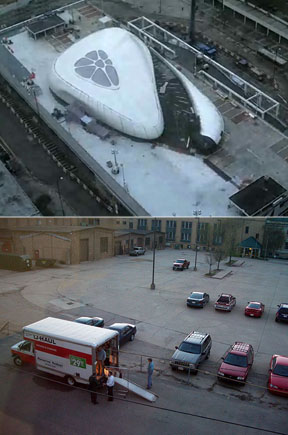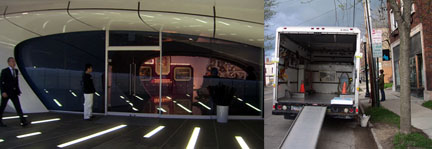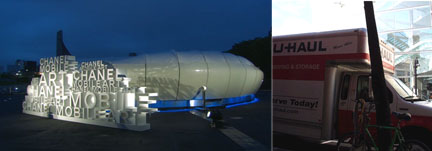
The "Celebrity Artists" did a fine job. One of the artists, Jonathan Yeo, was withdrawn from public display for a clever pun of falling leaves (oak, but think fig) with images of formerly covered genitalia. The Foundation is displaying and selling the Yeo chair at its website. See the Guardian. Bid now on online or attend the auction on June 3 in London

360 Degree Room of All Colours turns color into music. The circular space changes its pastel colors in slow repetition. The light level is PERFECT for the human eye in that pupil is fully open without the need to squint. If you stare into the fabric walls from 10 inches, your entire field of vision fills with one color. Only on a sail-less boat in the sea with a low sun, can you stare at the dome of the sky with a similar full view of blue. I loved it, but this is not the surprising part. If you sit of floor and a stare, the color change from washed out to very intensive pastel. My body started to feel the motion of the colors in ways that can only be compared to music. The chemical levels in my body shot up with the swelling of the color intensity.
Since architecture school, I had been told of psychological power of color, but never the physiological. Still part science, but like other chemicals in the body, I am hooked and looking for my next dose.

MOMA and PS1 prepare the public for the "Watersfalls" later this month in NYC. The the scaffolding has been constructed under the Brooklyn bridge. Photo taken on May 26.
From the Bay Area and Boston emerge artworks that are mainly science projects overlaid with pretty colors so they can be called "art". The interaction is fun for ten minutes and we like to take new visitors as they will marvel. We fake enthusiasm based on a memory our our first time so that we can truly enjoy their reaction. But the work fails to provide any personal thrill again. And for all the statements by the artists and curators, no significant thought comes to mind at all - except the terror of the possible future.
Olafur Eliasson moves between public science project and public art. Many are science tricks directed toward internal artworld reflections. A moving colorfield painting in light, the live black&white 3-D movie or the invisible white gallery box inside the white gallery box. Some are little silly like the reverse cascading waterfall where he sprays the water up from one pool to the next.
The genius of Eliasson emits from his stubborn battle with the photographic record: still or moving. He seeks to make works that can only be completely appreciated through "being-in" the artwork. (I have written about "being-in" regarding the architecture in the northwest USA - a place grounded in Scandinavian culture like Eliasson). Yet, many of Eliasson's best installations "The Weather Project" at the Tate Modern in London and the 360 Degree Room of All Colours at MOMA generate "artistic" amateur photos in the same way as Gromley's work. His is a battle, not a rejection.
ElliasonTatel.jpg
Anything claiming to be art requires the in-person experience to be fully appreciated. If you see a documentary picture or video of an artwork and think the artwork will be the same in person, then in my book you have a problem. (Of course the LCD monitor or paper magazine can be the intended home of the art.) The amateur photographs of The Weather Project make me want to be there. Through the photos, I have a sense, true or not, that the experience would be romantic and enveloping. Gromley's work makes me want to compete in the undeclared photo taking contest, not necessarily to be in the space. Eliasson's photos make me dream of the visit.
Two of the works at MOMA are brilliant and the "Take Your Time" room at PS1 exceeds any carnival fun-house of mirror rooms and tricks. Completely ignored by nearly all visitors, beige moss - of a type used for architectural models - densely covers each inch of the large gallery wall. Moss Wall is a visual trip over the Amazon Rain forest. Only by viewing the work from 6-10 inches can it unfold. As that visual range, the human eye and brain together imagine "depth of field" and a complete 3D visual experience that become physical. The human brain feels the tiny changes in elevation as you move your head and eyes like an airplane plane. But at 200 or 300 feet above a real forest, the eyes and brain do not feel any 3D effect. Eliasson discovered that multidimensional physical reactions can be sparked in the body.

Finally, Take Your Time at PS1. A huge disc cover red in reflective mylar rotates very slow on the ceiling. Immediately, everyone dives to floor and looks up. Your brain tells you that all the people - including yourself - are not lying on the floor, but suspended magically on a vertical wall with less effort that Spiderman. That is the fun house trick. The questions is - why do you want to lay there for minutes and minutes? People don't want to leave.
The mirror is tilted about 3%. Patience and 3% is the genius of the work. The angle causes the reflection of the visitors and the walls of the room to change very, very slightly in a loop. Again, somehow and for some reason, the brain knows that the view is changing and therefore remains alerts and interested. Unless you move the very edge of the disk, you can get yourself to consciously recognise the change. Like the colors in the 360 Degree Room, you body responds - in this case the brain - without consciousness.
Perhaps Eliasson has invented the first of science of art since gestalt.
I don't know how other creative people can utilize Eliasson's operational observations, but the work drives home the memory of special sunsets and hours napping adjacent to a waterfall in the forest. He proves that humans can make the spaces that facilitate these calm and happy moments. Thank you Mr. Eliasson.

How to think about public art? Do you just keep doing the same thing? Big art? Architectural intimacy? Site-specific narrative? Locally responsive?
Internationally, public art has been institutionalized as the founder's dreamed in the 1960 and 1970s. Big - intimate - narrative - responsive. Most importantly, appreciated by a small, but growing group, and accepted by most. Richard Serra's "Tilted Arc" would NEVER be removed today.
What was not anticipated was 1.) public art as a defined field separate from museum art and 2.) global uniformity. They could not have imagined 1.) daily Internet access to any public artwork and 2.) participation in public art through cell phones and Internet.
What has not materialized in the USA is 1.) respect for the individual artistic career and 2.) pride (or tolerance) in a culture that sponsors artworks of political and social content. Respect continues to expand for artists in the corporate or spectacular arts - movies, music videos, concerts, advertising, fireworks, theme parks, architecture (and some urban space or landscapes). For time being, the Internet provides the public venue for creative public works in politics and social observation.
Perhaps, the Internet removes the psychological need for public political expression in physical public art (except when used as a method to gain access to broader media channels and new audiences). At a recent dialogue at the New Museum in NYC with street artists selected by the Wooster Collective, politics had almost no role in the content of the art. These street artists personalized the generic elements of urban places such as billboards, light poles and road markings. Individualizing and manipulating the institutional forms has a political dimension as an act where acts by individuals are prohibited, but abandons public space as a canvas for unique commentary on culture.
As I try to come back to discourse - a mental activity removed from professional public art administration - I have been reading about "Relational Aesthetics". Although this theory that has inspired many public works of interaction among particular publics, Relational Aesthetics confirms the tiny, insignificant role of visual art by removing any cultural objectives beyond a knitting function for different groups and ideas. Any goals of global transformation are abandoned as 20th century failures. The dreams expressed as utopia have no value. Just make the best of the circumstances.
In general, theory is mainly the emphasis of one part of the same reality. "Making the best of circumstances" was an important element of any revolutionary act. In the 20th century, the objectives reigned supreme. Now the circumstances have the public relations edge, but art is still a singular act to make something that will change or reinforce human knowledge, values and future acts.
Revolution is a communal act in which art was a symbol and an example - not the motivation. A minority of artists - open to change and desiring notoriety - were frequently with the vanguard. In this world without hope in communal acts, Relational Aesthetics and contemporary public art practice makes sense as the symbol and an example. Make the best of circumstances with a clever mind, sensitive heart and functional results. Leave the best of all possible worlds to another generation.
Well that did not answer anything about public art. Except to say that the best public art in our time would be big, intimate, narrative and responsive with a functional justification and produced by an artist(s) with a clever mind and sensitive heart.
A lot of examination of public art this week (Sept 7-Sept 14, 2008). Get online or a subway car.
- Giant mechanical spider roams the streets of Liverpool, UK. Produced by Royal de Luxe, Artichoke and/or La Machine that produced the "Sultan's Elephant" in London in 2006.
- Dozens of small scale, site-specific interventions through out New York City via the Conflux Festival
- Blast Theory's new virtual/real space game can be played on-line in the morning on Friday, Saturday or Sunday (EST) (Click here to play) or at Royal Opera House in London for the Deloitte Ignite festival.
- Bronx Museum of the Arts opens the "Street Art" exhibition documenting a selection of performance or action driven outdoor artworks since the 1950s. Street festival on Sunday afternoon.
In May 2008, two Mobile Art projects were displayed in Tokyo, Japan and Madison, Wisconsin, USA.  The blog is composed of stolen images from Chanel Art Mobile website and the Curved Collective Flickr site and text from Art Daily press release and an email from Jennifer Anne in Wisconsin. The Chanel Art Mobile will be in Central Park between October 20 and November 9, 2008. Perhaps, the Curved Collective will join them in New York.
The blog is composed of stolen images from Chanel Art Mobile website and the Curved Collective Flickr site and text from Art Daily press release and an email from Jennifer Anne in Wisconsin. The Chanel Art Mobile will be in Central Park between October 20 and November 9, 2008. Perhaps, the Curved Collective will join them in New York.
My comparison is completely respectful of both projects. They both responded to their economic abilities. Curved spent $29.95 for the U-haul truck and volunteers set-up the mobile gallery at three locations on one day. Chanel has not revealed the cost of Zaha Hahid's pavilion for the 50-year anniversary of the Coco Chanel's design of the 2.55 handbag.
Comparing the public art events did spark a kind of checklist for public art project promotion.
- Reinforce the brand (Know what your brand is.)
- Produce a real event (What is wrong with celebrities?)
- Secure great photography, not good documentation.
- Partner with others that might benefit - but be in control yourself.
- Plan all events a long way in advance.
- Replace the word dedication with party.
- Always have great (big) signage.
Why not Chanel quality photographers for Curved? Entrances to Chanel and Curved Mobile Art Pavilions


Chanel really thought out the signage.
Perhaps one small critique. Hadid clearly ignored Chanel's request to respond to the 2.55 handbag, yet all the PR celebrates the conceptual relationship. This blind hype is what gives fashion a bad rap in the artworld.
Jennifer Anne from Curved Collective
The mobile art truck on my Flickr page was a roving gallery, rather than an interactive public art project like the ones on your blog/web page. Our artist group, the Curved Collective, had participated in Madison's biannual gallery nights in 'traditional' gallery spaces (four walls, a roof and a door) and wanted to do something different. Our Art Truck was a U-Haul in which we displayed our art at 3 different locations over the course of the Gallery Night evening. Some work was hung inside the truck; there was a site-specific installation on the ceiling of the truck; and 2 people had pieces on wheels that they displayed outside the truck at each location. At our second location we were rousted by the cops, who'd been called by the owners of the storefront adjacent to our (completely legit) parking space.
Art Daily Chanel Press Release
Mobile Art was commissioned by CHANEL and conceived by the company's renowned designer Karl Lagerfeld. It was originally imagined as a means to mark the first appearance fifty years ago of the iconic CHANEL "2.55" quilted stitched-leather handbag. Designed by Coco Chanel, the 2.55 has evolved over the decades into one of the most enduring examples of 20thcentury fashion - a kind of cultural totem collected by museums and coveted by consumers in countries around the world. That bag and the traditions of the factory in France, where it is still made today, were presented to Zaha Hadid and the participating artists as jumping off points for their contributions to Mobile Art. The resulting exhibition is a multi-dimensional meditation on fashion as a powerful, exciting, sometimes perverse and occasionally poignant conductor of fantasy, identity, culture and self-expression.
Zaha Hadid's response to Lagerfeld's Mobile Art concept was to create a pavilion that, like a handbag, is a completely portable and functional container with vast symbolic potential. Made of highly engineered, gleaming white arched fiberglass-reinforced polymer panels, the architect's enigmatic itinerant building is a sculpture in its own right. It is comprised of 700 components that, once assembled, appear to be a very distant abstraction the famous quilted CHANEL handbag. "There is a touch of quilting in the geometrical structure of the art Container," added Karl Lagerfeld.
For Mobile Art, CHANEL assembled a roster of leading contemporary artists with the assistance of Fabrice Bousteau, curator and editor of the art magazine Beaux Arts, and invited each to empty his or her proverbial bag in a singular way. Representing different generations, diverse nationalities and wide-ranging points of view, this group of artists has engaged in an exploration of the handbag as a way to examine an array of experiences, ideas and issues suggested by the intersection of art, fashion and architecture.
Mobile Art launched its two-year worldwide tour in Hong Kong in February 2008, before traveling to Tokyo, where it has been on view at the National Yoyogi Stadium Olympic Plaza. Following its presentation in New York City, Mobile Art will travel to London and Moscow, concluding its tour in Paris in 2010.







No comments:
Post a Comment